This is my ¼ scale, nine-foot wingspan 1941 Taylorcraft BC-12 D, built from my own plans over a period of several years beginning in 1995. This photo shows my wife Teryl and me with the airplane at TOP GUN 1999, where it was the first electric powered model ever to be included in the competition.
-=--=-([ezMigrate_tag])-=--=-([ezMigrate_tag])-=--=-([ezMigrate_tag])-=--=-([ezMigrate_tag])-=--=-([ezMigrate_tag])-=-/wp-content/uploads/2019/09/Taylorcraft2big1.jpg)
A bit of history…this is the complete, unedited text of an article I wrote years ago, when electric power for model airplanes was still considered an odd thing to be interested in.
BOB BENJAMIN’S TAYLORCRAFT
This is the story of an unusual model airplane. It is also the story of new challenges, new opportunities, and new ways of dealing with old problems that face model aviation. I have been working on this story for nearly ten years, and it is far from finished . While I know how I want it to end , the conclusion is far from certain, and you can play a part in seeing that it comes out right.
The airplane is a ¼ scale 1941 Taylorcraft BC 12-D , intended from the drawing of the first line on paper for competition. In its first three months of flying, it placed 11th in R/C Expert Scale at the 1997 AMA Nationals, qualified for and competed in the US Scale Masters Finals in Dallas, finishing in the middle of the field, and earned me a place as First Alternate to the US FAI World Championship Team to compete in South Africa in 1998. It also happens to be electric powered!
I have been building model airplanes since 1950 and flying R/C since 1963, when the first tentative prototypes of the sophisticated, reliable radios we all use today were beginning to show up on experimenters’ benches. Flying R/C in those days took a combination of skill, dedication and tenacity. In the late 1980’s, when flying radio controlled model airplanes and bringing them home in one piece most of the time had become a pretty sure bet, and I had gathered a lot of experience with model engines ranging from spark ignition old-timers to multi – cylinder four strokes, I discovered electric flight. I also rediscovered that old streak of tenacity and the determination to make something new work the way it was supposed to. I quickly learned that with cheap equipment, electric flight is an exercise in frustration, and that with good stuff it has exciting potential. It then occurred to me that electric flight is not about special types of airplanes. It is about a new kind of power for the airplanes we are already flying.
This doesn’t sound like a very profound insight, but when I looked at the airplanes being flown on electric power, many of the ones I saw were spindly, gawky looking models that gave the impression of making excuses. This is still true today. While there are some really impressive models being flown on electric, the majority still seem to confirm the idea that electric power is about lightweight, inexpensive models that can’t meet the performance standards set by glow engined jobs. Everywhere I went, I saw and heard modelers behaving as though they believed this to be true.
It seemed to me then that electric power for model airplanes could be the answer to a lot of problems, but that nothing much would happen unless a lot more people were persuaded to give it a try. You know how the story goes…lots of modelers had disappointing experiences with the cheap, underpowered electrics that several manufacturers introduced to the market a few years ago, and quickly lost all interest in electric power. The word got out that “electric doesn’t work”. The manufacturers quit trying, saying that there was no sales potential in electric, and the whole thing stagnated. Meanwhile, a few dedicated manufacturers continued to produce quality equipment, and a few dedicated modelers continued to get excellent results with it, but the model aviation world in general still hasn’t gotten the word.
My decision was to combine a lifetime of attraction to scale models with my new interest in electric power and to begin scale competition using electric powered airplanes. Sincere encouragement from my wife, Teryl, persuaded me to make the commitment. This had the effect of putting a giant charge of energy into my modeling I got out of the rut of “thinking about trying competition” at the same time that I chose to learn to use electric power to its full potential. My goal, while doing the kind of modeling I enjoy most, became the promotion of electric flight by drawing attention to this potential. I am trying to do this by flying the best scale models I can build, using electric power, against “engine powered” models in big – time competition. I am confident that if enough of us fly interesting, challenging electric airplanes where other modelers can see them, eventually the level of enthusiasm generated will entice more manufacturers into paying attention. The result of this will eventually be that more and better kits and equipment will become available, making it easier for more people to try electric power, and so on.
Why fly electric? There are lots of good reasons. Besides providing the obvious attraction of making no significant noise, electric power offers the modeler almost complete lack of vibration, totally fuel and oil – free operation, flexibility of equipment mounting, freedom from non – scale protrusions such as cylinder heads, guaranteed automatic starting and best performance on near – scale – size props. It is hampered by lower “power density” than engines (batteries are heavier than fuel tanks) and limited flight duration. Although AMA and FAI Scale rules have been changed in recent years to admit the existence of electric power, they make no special concessions. Modelers who choose to enter Scale competition using electric power do so under the same rules as competitors using engines. In part because of this, Scale competition is an excellent place to display the advantages of electric flight. Unlike aerobatic or racing events, Scale permits the modeler to select flight tasks based on characteristics of his particular full-scale subject airplane. This allows us to choose a model and flight presentation that can use readily available electric power equipment and do well in head-to-head competition with engine powered models without having to compete directly against the power loading and duration advantages of engine power. For instance, we can choose to build a design with plenty of wing area that is expected to fly at moderate speed and do only basic aerobatics, thereby maximizing the duration potential of our electric power system and showcasing its advantages. We can be competitive with the engine powered hot WWII fighters and jets if our electric airplane is built and flown as well as they are.
The ¼ scale Taylorcraft featured here is the latest in a series of electric powered scale airplanes I have built intending to go head-to-head with gas -engined models in major scale competition. After watching Bernard Cawley place second in Sportsman Scale at the 1989 AMA Nationals with a 1/6 scale electric Taylorcraft , I made the decision to get serious about competition, and rebuilt a 1/6 scale Porterfield “Collegiate” that had begun life as an Astro kit. In retrospect, had I known what was about to happen, I would have shelved the Porterfield and started an all-new, larger model. I took the Porterfield to several Scale Masters qualifiers during the summer of 1990, constantly making modifications, and ended up qualifying for the 1990 Dallas Masters Finals. This was not only the first time ever that an electric airplane had showed up at a Scale Masters, but also the first time one had even appeared at a qualifier!
My Porterfield finished 50th out of 75 at the ’90 Masters. She beat several “heavy metal” fighters, finishing all four rounds without damage in turbulent winds that forced quite a few other competitors to stand down. Her disadvantage was that she is too small and light (69” span; 7 ½ pounds) to have enough stability in rough air and general “presence” to be more competitive. I campaigned Porterfield again in ’91, but just missed making the cut for the Masters. Several friends suggested strongly that I choose a new scale project that would push the limits of existing electric power, in order to compete aggressively with the big fighters and command as much attention as possible. In retrospect, I should have built a bigger Porterfield! I spent a year building a ¼ scale Gee Bee Model “Y” Senior Sportster designed around the prototype Astro Cobalt 90, which “Astro Bob” Boucher made available to me when I told him about the decision to push the envelope with the Gee Bee. I test flew the 90, initially on direct drive, in an Ace R/C Big Bingo, chosen because its moments, airfoil and area were very close to those of the Gee Bee. It flew very well, even when ballasted up to the 23 pound weight of the Gee Bee. However, the drag of the Gee Bee’s 12” diameter cowl, bulky landing gear and full flying wires all worked against success. It was not until 1996, using a hotter version of the 90 and a belt drive reduction from ModelairTech, that the Gee Bee flew successfully. It still needs a little more “edge” to be a good competition airplane.
In the meantime, I built and flew a sport scale 81” span Spitfire based on the Dyna Flite kit. This airplane in its final, heavily modified form used a geared Astro 60 on 32 cells and had scale flaps and retracts. I flew it at the ’96 Nats and qualified for the ’96 Scale Masters with it, but wasn’t able to go due to business commitments. During the same time period I also built a 1/5 scale A6M5c Zero from a Dave Platt kit, modifying it to use a geared 10-turn (hotter) Astro 90 on 36 cells. The Zero flies well, and is accurate enough to have won 1st in Military Scale at the NW Expo (Puyallup) in 1996. I bent it taking off in gusty, turbulent wind badly enough to make rebuilding a major project, and decided to leave it on the shelf while building a new, more lightly loaded model that would offer a greater chance of success in competition.
While I was exploring the edge of the envelope with the Gee Bee, the Zero and Spitfire and several other smaller retract – equipped WWII fighters, my friend Randy Smithhisler converted a Sig ¼ scale J-3 Cub kit to use a direct drive Astro 90. Randy and I worked together on the details of the conversion, and when we put the first flight on the airplane, it was clear that we had found a practical formula for successful, competitive electric scale models. Randy immediately began work on a ¼ scale Piper PA-12 as a companion to his Cub, and I started laying out the Taylorcraft you see here. By the time of this writing (summer; ’97) Randy has flown in his first Nats and qualified for the Scale Masters himself with the PA-12! We both have “new and exciting” electric powered ¼ scale airplanes on the building board, as well as a couple of real “skunk works” projects being planned.
Let’s talk about the Taylorcraft in detail. The airplane was built over a period of two years, beginning in 1995, from plans I developed myself from various sources including published scale drawings, factory manuals, and extensive photos that I made of the full scale subject airplane. I had purchased a kit of a “sport scale” Taylorcraft, but after comparing it to the scale reference data I had collected, I abandoned it as a possible source of an accurate model and cannibalized the kit for usable material. Based on the experience Randy and I had with his ¼ scale Pipers, I knew that the 1700 sq. in. wing area Taylorcraft could be built to have good power for scale flying with sufficient duration to compete and still have a comfortable wing loading with a weight of between 19 and 22 pounds. I also knew that with reasonable attention to choosing light balsa and avoiding any excess structure not needed to sustain flight and landing loads (that is, ”built to fly, not to crash”), I would be able to use a painted fabric covering for accurate scale appearance, as opposed to an iron – on covering that might save weight but which would sacrifice static points to the degree that the airplane would not be competitive. It was also clear that I would be able to add scale detail such as a cockpit interior, working doors, simulated scale fasteners, and so on as long as each added bit of material was chosen to be as light as possible while maintaining just enough strength to be practical.
The airplane was constructed using medium – light balsa throughout, with spruce and aircraft ply in high stress areas such as wing spars, spar carry-through structure in the fuselage, and landing gear and motor mounts. The covering and finish are standard fullscale Stits Poly Fiber products, which I have found through prior experience to be excellent for models in this size range, and probably slightly lighter than other “paint and fabric” options. The rationale I followed was to build the airplane with no compromises as regards scale accuracy and durability for flying under contest pressure, while taking advantage of every opportunity to save weight by eliminating excess structure and choosing the lightest material that would do the job. The result is that my airplane weighs ten to fifteen percent more than would an electric sport scale model built using iron-on covering and completed without scale surface detail. As long as the airplane is flown in a scale – like flight envelope; in other words, with good power management and without extreme aerobatics, the extra weight is not an issue. I suspect that this would hold true for any airplane type with a light to moderate wing loading as long as design aspects contributing to drag are such that the airplane can be flown in cruise at or slightly above half power.
Our experience has shown that large, moderately loaded models flown on geared or beltreduced Astro 60 and 90 motors using the currently popular Sub-“C” NiCd cells of 1700 to 2000 mAh capacity can be built with accurate scale finish and detail and have useful flight durations on the order of 7 to 8 minutes when flown in a “scale” flight envelope. This has been proven sufficient to fly a full AMA scale presentation with a safe reserve for wind, other airplanes in the pattern, and the unexpected. The Taylorcraft uses 35 SR 2500 Max full “C” cells for extra duration potential. (Note that Astro’s max recommended cell count for the 90 on the “standard”, low-ratio gearbox is 36 cells; I am using 35 because of an obscure provision in the current FAI R/C Scale rules.) These increase the weight of the airplane about 1¼ pounds over what it would be with sub “C’ cells, to a flying weight of 21 ½ pounds. This works out to a wing loading of 28½ ounces per sq. ft. So loaded, the model lives up to the name “Floater” often applied to the full scale airplane! Max flight duration experienced so far in competition is just over 11minutes during a round when it was necessary to circle repeatedly the field while other aircraft took off and landed. I still had power left after taxiing in. This compromise of extra weight for extra duration was planned into the airplane from the outset, and has worked just as planned. I doubt that weight saved by changing to a lighter battery pack would result in any significant change in flight performance. The geared Astro 90 is turning an 18-12 prop, which is a Zinger subjected to my usual rework of thinning and undercambering. This rework process is used on every prop I fly, and is in fact the basis of the new Master Airscrew Electric series. (The series does not yet include props large enough for the 60 and 90.) Full throttle static current draw is about 28 amps, which is low for this motor. This combination gets the airplane off grass strips in about 100 feet and allows half throttle cruise and scale – like aerobatics like wingovers and lazy eights without the diving entry needed by the full scale airplane. There is significantly more power available from this motor . I have chosen to set up for less because the Taylorcraft doesn’t need it.
This airplane points the way to a lot of good things in the future. Randy Smithhisler and I have now been flying big scale airplanes on electric power in heavy – duty competition through several contest seasons, with excellent results. While contest flying is not for everyone, I submit that the precedent our models have set will make it easier for you to commit to trying larger, more challenging electric airplanes. ELECTRIC WORKS , and as the technology improves, it will work even better. Sufficient interest on the part of modelers in the form of repeated purchases of good electric equipment will send the right message to the manufacturers, and the quality and selection of electric flight systems will improve even faster. This is where you come in. As the man said, “Try it, you’ll like it!”
EPILOG: In the spring of 1999, the Taylorcraft became the first electric powered model ever to compete at TOP GUN, and a year later in 2000 I managed to place Fifth in Master Scale to become the first modeler ever to win cash and a trophy at TOP GUN with an electric powered model. As I write this material in 2011, the airplane is still in my shop, parked safely on a shelf, still ready to fly should I choose to take her out to the field again. The old Astro 90 motor has been replaced by a brushless outrunner and the battery pack is now made up of six 5300 mAh Lithium Polymer cells. With that equipment, my old Taylorcraft has a margin of extra power that is at least twice what I’d need to fly a competitive routine, and I could probably keep the airplane in the air for half an hour if I wanted to, but that’s no big deal. Thanks to a big increase in interest and serious technical development, electric powered scale models are now do that and more as a matter of course. I like to think that my Taylorcraft played a part in making that happen.

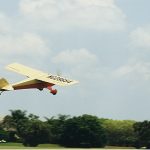
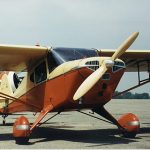
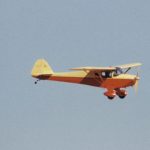
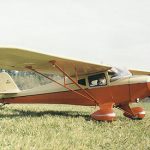
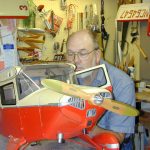
Currently building a Lanier 1/4 scale Taylorcraft. Can you tell me where you purchased or how you fabricated the cowling grills ?
David, there is no easy answer to that one. As is the case with lots of models of less-familiar airplanes you have to make this stuff yourself. In the case of my T-Craft I cut and shaped each of those little pieces by hand
using lithoplate (aluminum sheet) stock.
BTW: You might enjoy reading my new book Hey Mister, Will It Fly? You can check it out at rcmodel.com/bobs-books/ and order a copy online if you are interested.
Bob